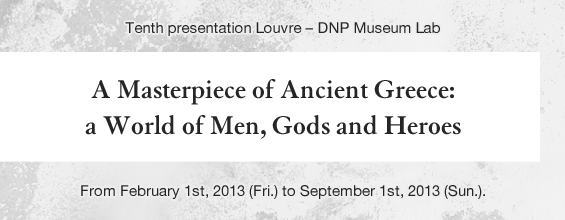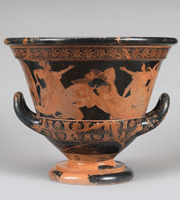|
|
 The mythology of ancient Greece is rich in stories of men, gods and heroes. Many of these tales are illustrated by the sculptures and painted ceramics that have come down to us.  Red-figure calyx krater
Signed by the painter Euphronios, attributed to the potter Euxitheos Athens, c. 515–510 BC Clay H. 44.8 cm; Diam. 55 cm Provenance: Cerveteri (Italy) Campana collection, 1861 Department of Greek, Etruscan and Roman Antiquities. G 103 (Cp 748) Paris, Musée du Louvre © Photo DNP / Philippe Fuzeau One such story is depicted on the "Krater of Antaeus" ‒ a masterpiece of Greek pottery that visitors will be able to admire at our tenth presentation, entitled "A Masterpiece of Ancient Greece: a World of Men, Gods and Heroes". The krater depicts the most famous Greek hero, Heracles, the son of Zeus and a mortal woman, renowned for the legendary strength that enabled him to fight monsters and brigands; the scene shows him in the act of slaying the giant Antaeus. This superb scene was the work of Euphronios, an Athenian painter active in the late 6th century BC; the theme of the fight was a pretext for a detailed representation of figures in movement. On display near the krater is a bronze copy of a work by the Greek sculptor Lysippos, "Heracles Resting". Here, the hero's magnificent musculature is highlighted as he leans on his club after completing his twelve labours. The multimedia displays give visitors an unusual and unforgettable insight into painted ceramics and Greek sculpture, while drawing their attention to every detail and providing keys to a better understanding of the works. Visitors will learn to recognise the gods and goddesses of the Greek pantheon while following the development of the representation of the human body in Greek art ‒ the result of anatomical research and a constant quest for perfection. The krater—the centrepiece of this presentation—also provides an introduction to a key aspect of Greek society: the banquet or symposion (Greek for "drinking party"). This occasion for conversation and entertainment was presided over by Dionysos, the god of wine, a mask of whom is also on display here. Visitors can enter a space devoted to this aspect of Greek social life, to get a feel of the festive and musical atmosphere at these gatherings. This presentation is designed to introduce visitors to the artistic expressions of a civilisation whose influence on Western art and culture was considerable. With these artworks from the distant past, the vibrant history of the men, gods and heroes of ancient Greece comes to life before our eyes. |
||